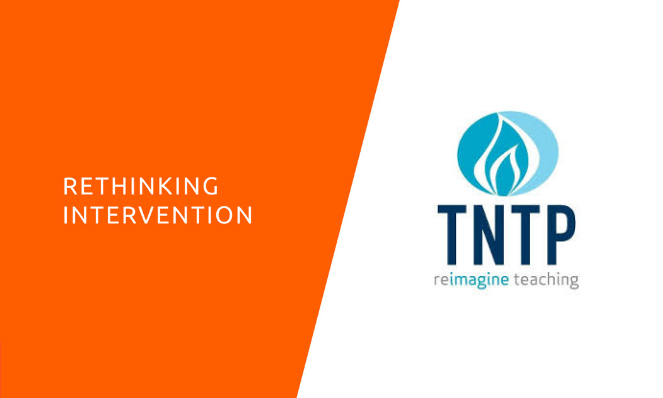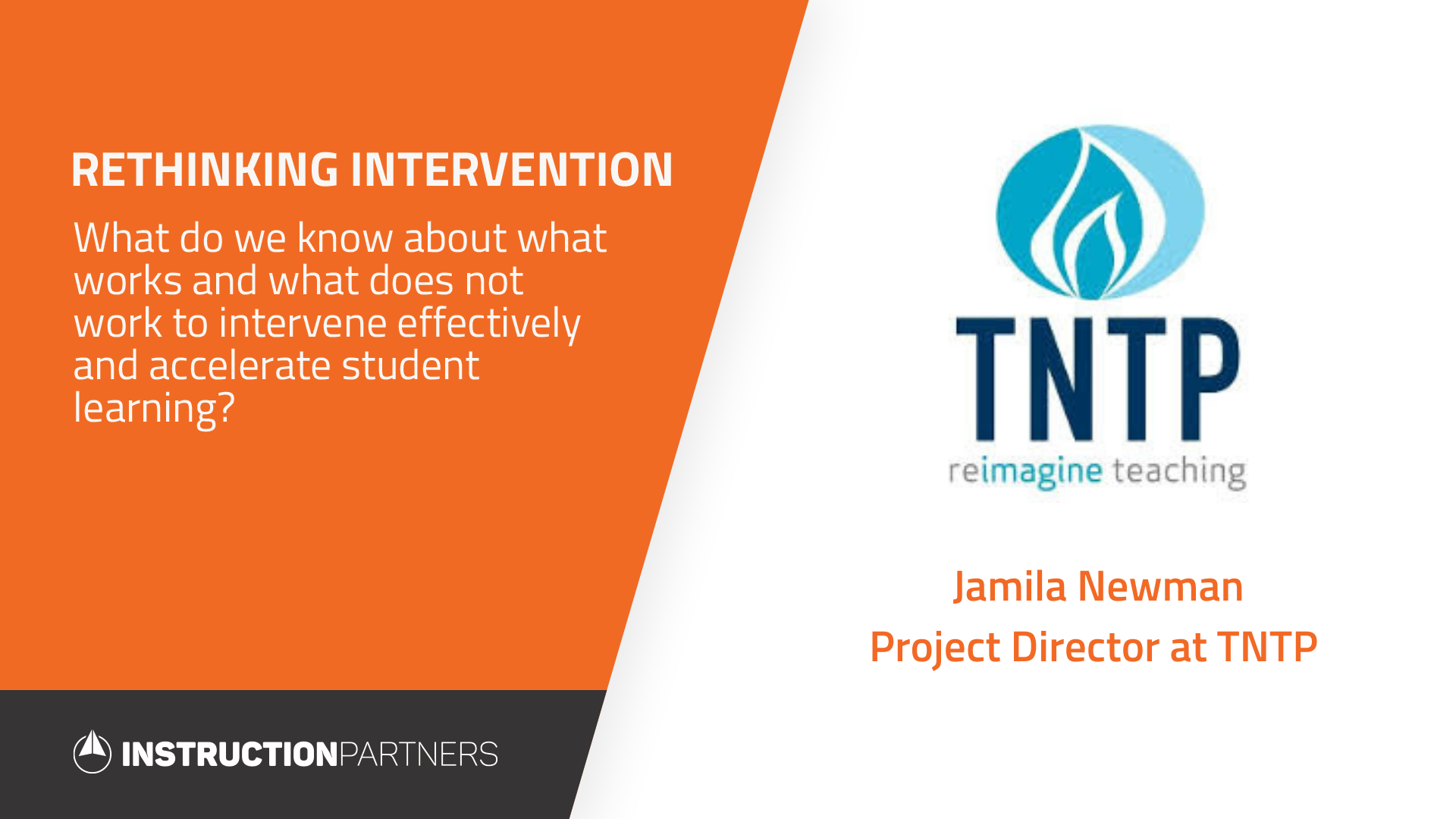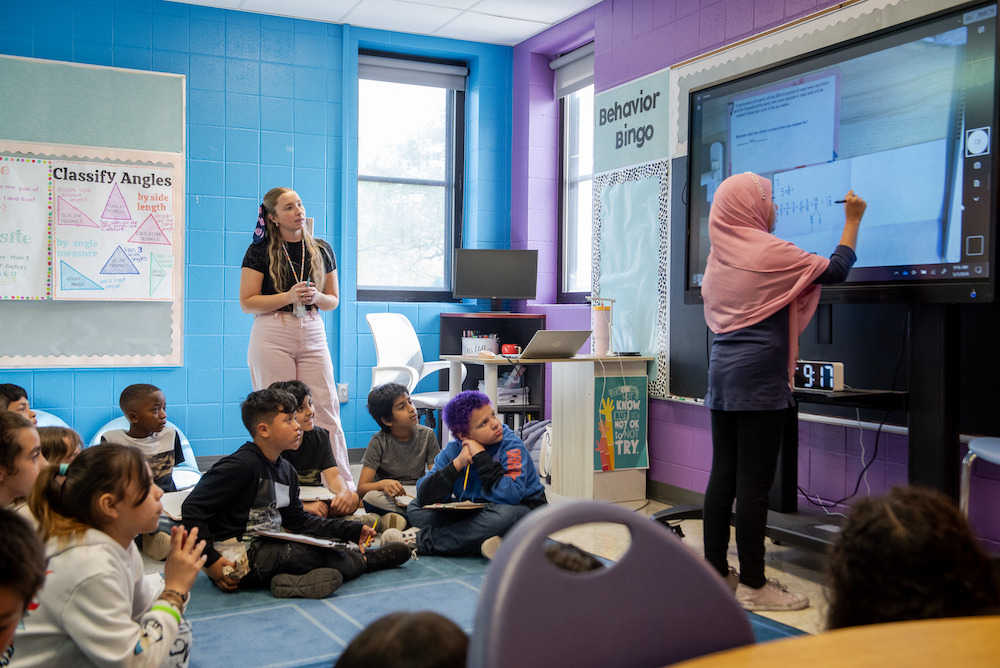
Jamila Newman, TNTP
Jamila Newman, Project Director at TNTP, spoke to Emily Freitag about the importance of high expectations and strong instruction to the charge of accelerating student learning.
Watch the full conversation or read the abridged Q&A below.

EF: Please tell us your story as a student and what that taught you about learning.
JN: I was born in Kansas City, Kansas, and was lucky enough in Kansas City to go to black-owned private schools. My parents sacrificed a lot on their graduate student salaries to have my brother and I go to the best education facilities possible. We moved from Kansas City when I was going into second grade to a small town in Ohio. It was the first time that I felt behind and I was really struggling to read. I was a proficient reader in terms of I could read the words on the page. But making sense of those words was a struggle for me. I was also a really quiet child. And this was when IEPs, and titling programs were just kind of starting to wake up in the country. So they were on their way to sending me to a special education classroom. My mom came in and she’s like, “She can do the work. She just doesn’t like to talk, test her again.”
They tested me again, and I did have a reading comprehension issue. And I really think it was a strong reflection of where the country was when we think about the reading wars. My brother had a teacher who was very “old school,” and taught systematic phonics. My brother to this day is a stronger speller than I am, and his ability to break down complex words was very different. And now in hindsight looking in on it as an educator, I can understand the experience that he had in education versus the experience that I had. And I still feel the ramifications of that today.
So that’s really carried forward in how I approach my work and how I think about my work, both from the perspective of, how do we support students who may have some unfinished learning? And, how do we communicate with parents about unfinished learning and communicate with kids about unfinished learning in ways that don’t create further trauma or stigmatize students or give them a sense that they don’t belong in a rigorous educational environment?
EF: Thank you so much for sharing that. The Opportunity Myth from TNTP was so instructive to this moment. Tell us now, from your seat as an education leader, what you have seen over time from experience and research and practice, what do we know actually does work?
JN: I think asking that question, “What does work?” in this environment is tricky, because as a nation we’re facing unprecedented times. So we started to pivot and say, while we might not know exactly what works, we know what has not worked, and we’re starting to push people on the science of their teaching. What is it rooted in? Is it rooted in what you experienced as a learner, is it rooted in a kind of folklore of teaching? Or is it rooted really in the research and the best practice and the science that we know as a field? And so we’re trying to talk about the narrowing of the gap between the science and the teaching that we do so that we can capitalize on our learning.
We know that leveling students and only having them read material on their independent reading level has not been successful. It hasn’t served students well. We know that not providing students with systematic foundational skill instruction has not served them well. We know that not marrying writing with what students are reading has not served students well. We know that not allowing students to have lots of at-bats with complex texts has not served them well. Have we always acted on what we know? Have we done better because we know better? Not so much. And so I think that’s the piece that I’m excited about about where we are right now in the educational community is that I’m hoping that this experience is really creating a forcing mechanism for folks to say that we’ve got to get out of our own way, and get out of the way of students, as adults. We’ve known a lot of best practices for years but we haven’t been comfortable really demanding it of other adults or even ourselves to make that change. And I think this calls for an opportunity to do that.
EF: Take us into The Opportunity Myth a bit more deeply. This is looking back at instruction before COVID of course, but what did you all learn about the truth of the student experience, and in particular, the equity of instructional access?
JN: I think our research aligned to research that was already out there that students are very perceptive about the educational experiences that they’re having. Often as adults, we’ve discounted their perceptions. But they are very accurate and real in many ways. I think we also had the assumption that when we as educators or skilled observers saw something as high-quality, or as engaging from an observer’s perspective, that students would also feel the same way and that was not the case. There is so much more power than we even necessarily. initially believed in high expectations and strong instruction and the relationships that teachers have with students that play into how students engage with even high-quality materials. So it enforced this idea that high-quality materials will give you a significant lift, but they are not the only thing that you need to be thinking about and considering.
EF: So there was much more about the relationship between strong instruction, high expectations, student teacher relationships, and then curricular materials as sort of an enabler of all of that. Can you dig in a little bit more about what you realized?
JN: I think we thought that there was a cleaner arrow between if we saw high-quality materials in the classroom that was strongly aligned, or if we had evaluated something as being strong instruction, then that would lead to students being more engaged. But that equation didn’t always work. And as we rethink our teacher development framework, it really pushed us to think beyond resources. There’s this innate need for students, and humans and adults in general, to feel a sense of belonging, to feel a sense of relevance and purpose. That is what activates and accelerates the learning in a way that we didn’t even necessarily hypothesize. And we thought high-quality materials were going to be the thing that really grabs students’ engagement and attention. They did do a lot of strong things for students. But there was so much skill and nuance from the teacher needed to lift those materials up. The research really illuminated that for us.
EF: Dig in a little bit more on expectations. I think that was a place that you did find a little bit of a clearer arrow.
JN: Expectations was a leading piece where, especially for students who were the furthest behind, had the biggest impact on their growth within a year. And so it made us think about, How are we orienting teachers to begin thinking about, What is the classroom that you’re going to experience? And we’ve been talking a lot about classroom archetypes. So, how are we setting the record straight about what the average classroom in America is so that teachers aren’t having thisfalse narrative of, if a child has unfinished learning, that it means something detrimental or something is wrong? It is the rule as opposed to the exception that you’re going to have students with unfinished learning. It’s the rule and not the exception that you’re going to have students who are multilingual learners. It’s the rule and not the exception that you’re going to have students who you’re going to need to be cognizant of any biases related to socio-economic status. There is so much unpacking that needs to happen that is playing into the expectations that teachers have both about their students’ ability to do the work and their own ability to make that growth happen for kids.
How are we defining what high expectations look like? In the past, we’ve used models that kind of espoused high expectations but didn’t necessarily enact them. People using cheers or chants or putting college things on the wall is all important, but if in our day-to-day actions we’re putting work in front of students that doesn’t express high expectations, or in day-to-day interactions with students or their families we’re not being honest with them about where they are in terms of their achievement or proficiency, then that erodes the honesty of our high expectations. It has created in us a push to explore how we’ve kind of checked off “you have high expectations,” versus really leaning in with people and asking questions and engaging in focus groups or one-on-one conversations with teachers that begin to unpack or uncover their perceptions, either positive or negative about the communities that they’re going to work in.
We’ve been trying to ask this question related to high expectations of, “Who’s achieving within your system and why are they achieving?” and, “Who’s not and what’s happening there?” And consistently asking that “why” question and digging in with folks because I think what we’ve also really surprisingly found is if you’re looking at the data from a much more high level, you can walk away from a district or system feeling good. But start digging into more of the subgroups and, and at the classroom or school-level, that’s when you see the disparities come alive. And so we’ve been pushing in our data analysis with clients to go much deeper by asking that question and then using our work with them to really dig in and analyze data in a much deeper way.
EF: The day will come when there is either a treatment or a vaccine and there is an end of the pandemic. What do you hope educators will think about and do in the spirit of the evidence we have about what works to accelerate learning?
JN: The first thing is, we’ve got to figure out better ways to learn from each other, to collaborate, and to take things to scale. I think so many of my clients struggle to learn about best practices that are out there in a way that really allows them to think through the conditions and contexts that made that work, as opposed to just, “I overheard randomly that someone out there is doing x, I’m going to try it here.” Instead, knowing all the moving parts of why that was successful. So that’s one.
The other thing in terms of accelerating learning is you can look at the concept of accelerated learning and think of it as simply a reshuffling of the standards deck, of like, “I’m just moving standards from here to there and not really understanding how it needs to marry strong instruction and socio-emotional responsiveness.” Because if you’re just plowing ahead with accelerated learning, you can in fact cause more trauma to your system. And so I hope that systems adopt the idea of accelerated learning that we can put students in grade-level appropriate content much faster and much more frequently than we have in the past. And that in order to do that, we’ve got to really start to build skill with both leaders and teachers about what effective differentiation and scaffolding looks like so that we’re not reducing the rigor of our instruction but maintaining that bar.
And I think the other piece that I’m hoping is that this problem really allows us to trim the fat from our instructional practices so that we can more closely examine our instructional design. I think there’s a lot of conversation right now about diagnostics and assessments and understanding where students are in response to COVID. But I don’t necessarily know if we’ve come back to the idea that even before COVID, our assessments were not doing the job that we needed them to do. I don’t necessarily know if I personally would have put a stamp on any assessment as giving teachers or educators the tools that they needed to really strongly inform their instructional practice. We need to decide as a nation, what are these assessments for? Are they simply to give us a benchmark for students or are they to drive instruction? And maybe it’s a combination of things. But what I hope from this whole process is that it’s forcing us to ask the big questions about: What do we really need from education? What do we need from educators? What lanes do we need individuals to play in? And where have we kind of just been spinning the wheels or adding things that are unproductive or unsuccessful, or we haven’t seen the return on investment and like, get rid of it, because the education landscape is already crowded enough and it’s becoming more crowded in this space. And that’s really what I’m hoping.


